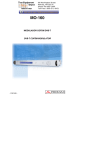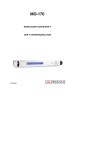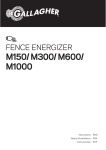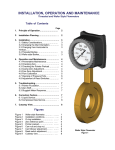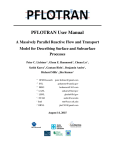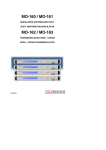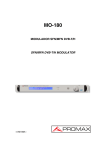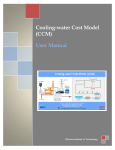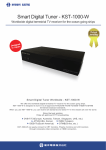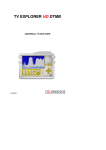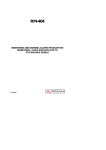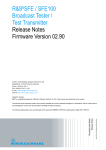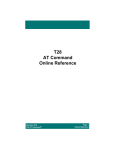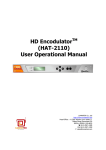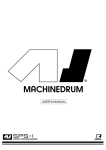Download MO-270 manual
Transcript
MO-270 DTMB MODULATOR - 0 MI1637 - SAFETY NOTES Read the user’s manual before using the equipment, mainly " SAFETY RULES " paragraph. on the equipment means "SEE USER’S MANUAL". In this The symbol manual may also appear as a Caution or Warning symbol. Warning and Caution statements may appear in this manual to avoid injury hazard or damage to this product or other property. USER’S MANUAL. MO-270 T A B L E OF C O N T E N T S 1 GENERAL.................................................................................................................. 1 1.1 General description ............................................................................................. 1 1.2 Functional description ......................................................................................... 1 1.3 Specifications ...................................................................................................... 4 2 SAFETY RULES........................................................................................................ 7 2.1 General safety rules ............................................................................................ 7 2.2 Descriptive Examples of Over-Voltage Categories ............................................. 8 3 INSTALLATION ......................................................................................................... 9 3.1 Power Supply ...................................................................................................... 9 3.1.1 Operation using the Mains ............................................................................ 9 3.2 Installation and Start-up ...................................................................................... 9 4 OPERATING INSTRUCTIONS................................................................................ 11 4.1 Front panel description...................................................................................... 11 4.2 Rear panel description ...................................................................................... 12 4.3 Menu functions .................................................................................................. 13 4.4 MODULATOR functions. ................................................................................... 13 4.5 RF functions. ..................................................................................................... 15 4.6 LEVEL functions................................................................................................ 17 4.7 NOISE ............................................................................................................... 17 4.8 ECHOES ........................................................................................................... 18 4.9 CONFIGURATION functions............................................................................. 19 4.10 STATUS ............................................................................................................ 20 4.11 REMOTE control through RS-232 interface ...................................................... 21 4.12 DTMB useful bit rates........................................................................................ 27 4.13 Error Information ............................................................................................... 28 4.13.1 Types of errors ............................................................................................ 28 4.13.2 Error Coding................................................................................................ 29 5 MAINTENANCE ..................................................................................................... 31 5.1 Mains fuse replacement .................................................................................... 31 5.2 Cleaning Recommendations ............................................................................. 31 APPENDIX A: Channel Plans USER’S MANUAL. MO-270 USER’S MANUAL. MO-270 DTMB MODULATOR MO-270 1 GENERAL 1.1 General description The MO-270 is a DTMB modulator fully compliant with the standard GB20600-2006. The modulator input is an MPEG-2 transport stream (TS) in ASI format. The outputs are DTMB signals up converted to IF and RF. The MO-270 supports Single Carrier and Multicarrier modes and can be used in Multi Frequency Networks (MFN). Digital coding and modulation are implemented by means of programmable logic devices based on PROMAX own technology. This makes the design highly flexible, allowing it to tailor it to any particular application, and offering plenty of features at low cost. Highlights of this product are: • Single Carrier and Multicarrier mode of operation. • High frequency resolution (in steps of 1 Hz). • High MER. 1.2 Functional description The MO-270 is a general purpose DTMB modulator contained in a 19" 1U chassis. The unit has two serial MPEG-2 TS-ASI inputs. Either of these inputs can be used to modulate the DTMB signal. An additional test TS can be generated internally in the modulator. This allows generating compliant DTMB signals even in the absence of a valid TS input. The MO-270 is able to work with any incoming bit rate as long as this is strictly lower than the value given in the DTMB specification for the modulation parameters in use (See section ‘4.10 DTMB useful bit rates’). The input TS bit rate is adapted (bit rate adaptation) to the useful bit rate required by the DTMB signal by stuffing the TS with NULL packets (packet stuffing). This stuffing process alters the sequence of PCR values embedded in the TS. These values have to be re-stamped for the resultant PCR jitter to remain within the acceptable limits specified by the DTMB. 01/2009 Page 1 USER’S MANUAL. MO-270 Whenever possible, it is advised to use an input bit rate considerably lower than the nominal value given in the DTMB specification. Otherwise, an input rate too close to the required value might eventually lead to overflow of the TS packet buffer implemented in the modulator. The modulator can be configured to generate any of the transmission modes listed in the DTMB specification. Several test modes are available in the MO-270 (single tone output and test TS generation). The modulator is frequency agile. The user can select an RF output frequency between 45 and 875 MHz in steps of 1 Hz. In normal operation, the IF output frequency is internally set by the modulator and varies between 31 and 36 MHz depending on the selected RF frequency. The RF output can be switched off, in which case the IF frequency is fixed at 36 MHz. The polarity of the IF/RF spectrum (inverted or noninverted) can be selected by the user. The MO-270 has been designed to work in Multi Frequency Networks (MFN). Single Frequency Network (SFN) operation is not currently supported. The MO-270 can add white Gaussian noise to the DTMB signal with a given Carrier-to-Noise Ratio (C/N). This random noise is generated digitally and is available on both IF and RF outputs. The noise bandwidth is more than twice the bandwidth of the DTMB signal. The noise generator can be easily switched on and off. When it is on, the user can select the C/N ratio. The valid range is 3 to 40 dB in 0.1 dB steps. Because both noise and signal are generated in the digital domain, the accuracy of the so-simulated C/N ratio is very high. The average power of the noise within the signal bandwidth can be easily measured at the output of the modulator by switching the useful signal off (Menu entry Suppress Carrier: NO / (YES)). Obviously, the measured noise power will be approximately C/N dB below the DTMB signal power. Note that the DTMB signal power remains the same regardless of whether noise is added or not at the output. The channel simulator implemented in the MO-270 allows the user to simulate both dynamic and static multipath scenarios. Up to 6 echoes (including the main path) of variable amplitude, delay, phase and Doppler frequency can be selected. The time-varying complex-baseband channel is simulated in the digital domain according to the following equation: h(t ;τ ) = ρ1e Page 2 j ( 2πf D ,1t +φ1 ) 6 +∑ ρne n=2 j ( 2πf D , nt +φn ) δ (t − τ n ) 01/2009 USER’S MANUAL. MO-270 Echoes 2 to 6 have amplitude ρn, constant phase φn, delay τn, and pure Doppler frequency fD,n. Echo number 1 has amplitude ρ1, constant phase φ1, and Doppler frequency fD,1. Its delay is assumed 0 and therefore it is taken as the time base reference for all the other echoes. When fD,n = 0 for all n, the channel does not vary in time and h(t;τ) = h(τ). This is the channel used to characterise fixed or roof-top reception. It’s usually nonetheless useful to add some Doppler (1 or 2 Hz) to a static channel in order to slowly stir its phase. For echo number n, n = 1…6, its amplitude ρn is computed using the following formula: ρn = 10 6 An 20 ∑10 An 10 n =1 where An is the amplitude of echo number n referred to the echo of maximum amplitude of the channel and expressed in dBc (valid range is 0 dBc down to –40 dBc in 0.1 dB steps). Note that the echo of maximum amplitude is not necessarily the first echo as happens, for instance, when pre-echoes are present in the channel. The above formula normalises the channel so that the total power of the DTMB signal (sum of echoes) remains equal to the nominal DTMB signal power when no echoes are present. The range of echo delays goes from 0 to 541.6 µs and can be incremented in steps of 0.1 µs for each of the six echoes. The echo phase is fixed, ranging between 0° and 359.9° in 0.1° steps. The Doppler frequency has a valid range of -830 Hz to +830 Hz in +0.1 Hz steps. Note that, depending on the output frequency in use (36 MHz IF or RF), the same baseband Doppler frequency may correspond to different vehicle speeds. The modulator is frequency agile. The user can select an RF output frequency between 45 and 875 MHz in steps of 1 Hz. In normal operation, the IF output frequency is internally set by the modulator and varies between 31 and 36 MHz depending on the selected RF frequency. The RF output can be switched off, in which case the IF frequency is fixed at 36 MHz. The polarity of the IF/RF spectrum (inverted or noninverted) can be selected by the user. The operation of the MO-270 is done via the front panel LCD display and controls. The modulator can be easily configured by navigating through a rather intuitive set of menus. A couple of LEDs located on the front panel signal the existence of errors in the modulator or whether the equipment is properly powered. 01/2009 Page 3 USER’S MANUAL. MO-270 1.3 Specifications INPUTS MPEG-2 Transport Stream Operating modes IF OUTPUT Type Frequency range Spectrum polarity Power level (average) In-band amplitude ripple In-band group delay ripple Frequency stability MER RF OUTPUT Type Frequency range Spectrum polarity Power level (average) Frequency stability MER SSB phase noise DTMB PARAMETERS Carrier Mode Frame Header Length Frame Header Phase FEC rates Constellations Time Interleaving MFN operation Page 4 Two ASI inputs, 75 Ω female BNC. TS packets of length 188 or 204 bytes. (automatic detection). Support for burst and continuous packet mode. Input TS bit rate strictly below the value given in the DTMB specification. Packet stuffing for bit rate adaptation and PCR re-stamping are carried out automatically. 50 Ω BNC female connector. Variable between 31 and 36 MHz in steps of 1 Hz; fixed at 36 MHz when RF output is off. Selectable via front panel controls. 0 dBm (107 dBµV) fixed. < 0.5 dB. <10 ns. 20 ppm. > 43 dB. 50 Ω N-type female connector. Adjustable between 45 and 875 MHz in 1 Hz steps. Selectable via front panel controls. Approximately 80 dBµV with no attenuation. Variable attenuation of 0 to 60 dB in steps of 1 dB. 20 ppm. > 38 dB. ≤ -87 dBc/Hz @ 2 kHz. Single, Multicarrier. 420, 595, 945 symbols. Fixed, Rotating. 0.4, 0.6, 0.8. 4QAM-NR, 4QAM, 16QAM, 32QAM, 64QAM. 240, 720. Available. 01/2009 USER’S MANUAL. MO-270 NOISE GENERATOR Characteristics Bandwidth C/N CHANNEL SIMULATOR Characteristics Number of taps Profiles Amplitudes Delays Doppler Phase TEST MODES Single carrier (R.M.S Tone) TS packet generation NOISE GENERATOR Characteristics Bandwidth C/N 01/2009 Fully digital complex baseband generation. Both signal and/or noise can be switched off. Flat within twice the bandwidth of the DTMB signal (±1 dB of flatness within the DTMB bandwidth). 3 to 40 dB in 0.1 dB steps (noise power varies whilst the DTMB signal power remains constant). Fully digital complex baseband generation. 6 echoes, which may be switched on/off individually. Pure Doppler shift or constant phase. 0 to -40 dBc in 0.1 dB steps. 0 to 541.6 µs in steps of 100 ns - 8 MHz channels -830 to 830 Hz in 0.1 Hz steps. 0 to 359.9° in 0.1° steps. Generate a single carrier at the channel central frequency whose level equals the average DTMB output power. This is intended for signal level alignment. Internal generation of test TS using PRBS sequences of length 15 or 23 embedded within NULL packets. Fully digital complex baseband generation. Both signal noise can be switched off. Flat within twice the bandwidth of the DTMB signal (+-1 dB of flatness within the DTMB bandwidth). 3 to 40 dB in 0.1 dB steps (noise power varies whilst the DTMB signal power remains constant). Page 5 USER’S MANUAL. MO-270 ECHOES GENERATOR Amplitude Phase Doppler Delay From 0 down to —40 dBc in 0.1 steps. From 0° to 359.9° in 0.1 steps. Static (0 Hz) / Dinamic (from +- 830 Hz). Variable in 100 ns steps. RS-232C INTERFACE POWER SUPPLY Voltage Frequency Consumption 90 - 250 VAC. 50 - 60 Hz. 20W. OPERATING ENVIRONMENTAL CONDITIONS Indoor use Altitude Up to 2000 m. Temperature range From 5 °C to 40 °C. Max. relative humidity 80 % (up to 31°C), decreasing lineally up to 50% at 40 °C. MECHANICAL FEATURES Dimensions Weight 19" (W.) x 1.75" (H.) x 15" (D.). 6.3 kg. RECOMMENDATIONS ABOUT THE PACKING It is recommended to keep all the packing material in order to return the equipment, if necessary, to the Technical Service. Page 6 01/2009 USER’S MANUAL. MO-270 2 SAFETY RULES 2.1 General safety rules * * * * * The safety could not be assured if the instructions for use are not closely followed. Use this equipment connected only to systems with their negative of measurement connected to ground potential. This is a class I equipment, for safety reasons plug it to a supply line with the corresponding ground terminal This equipment can be used in Overvoltage Category II installations and Pollution Degree 1 environments. When using some of the following accessories use only the specified ones to ensure safety. Power cord * * * * CA005 Observe all specified ratings both of supply and measurement. Remember that voltages higher than 70 V DC or 33 V AC rms are dangerous. Use this instrument under the specified environmental conditions. The user is only authorized to carry out the following maintenance operations: Replace the fuses of the specified type and value. On the Maintenance paragraph the proper instructions are given. Any other change on the equipment should be carried out by qualified personnel. * * * * The negative of measurement is at ground potential. Do not obstruct the ventilation system of the instrument. Use for the signal inputs/outputs, specially when working with high levels, appropriate low radiation cables. Follow the cleaning instructions described in the Maintenance paragraph. 01/2009 Page 7 USER’S MANUAL. MO-270 * Symbols related with safety: DIRECT CURRENT ALTERNATING CURRENT DIRECT AND ALTERNATING GROUND TERMINAL ON (Supply) OFF (Supply) DOUBLE INSULATION (Class II protection) CAUTION (Risk of electric shock) PROTECTIVE CONDUCTOR CAUTION REFER TO MANUAL FRAME TERMINAL FUSE EQUIPOTENTIALITY 2.2 Descriptive Examples of Over-Voltage Categories Cat I Low voltage installations isolated from the mains. Cat II Portable domestic installations. Cat III Fixed domestic installations. Cat IV Industrial installations. Page 8 01/2009 USER’S MANUAL. MO-270 3 INSTALLATION 3.1 Power Supply The MO-270 is equipment powered through the mains for its operation. 3.1.1 Operation using the Mains Connect the instrument to the mains through the AC voltage connector [12] located on the MO-270 rear panel. Check if the mains voltage is according to the equipment specifications. 3.2 Installation and Start-up The MO-270 modulator is designed for use as a rack-mounted 19 inches device (1U chassis). Switch the main switch [13] located in the rear panel to position I (power on). After a successfully start up, the equipment emits four acoustic tones to indicate that it is ready to begin operation. When the equipment is connected to the mains, the green LED LINE [3] remains lit. 01/2009 Page 9 USER’S MANUAL. MO-270 Page 10 01/2009 USER’S MANUAL. MO-270 4 OPERATING INSTRUCTIONS WARNING: The following described functions could be modified based on software updates of the equipment, carried out after manufacturing and the publication of this manual. 4.1 Front panel description MO-270 DTMB MODULATOR MO-270 DTMB Modulator v1.1.00 (c)2009 PROMAX Electronica,SA 1 2 3 4 5 Figure 1.- Front panel. [1] LCD display With 2x40 characters crisply clear due to its white LED backlight. [2] ERROR RED LED has a couple of functions. For each operating second, the first tenth of that second indicates whether there are sync problems in the modulator (ON) or not (OFF). Examples are loss of TS sync or invalid input bit rates. The remaining nine tenths of a second, the RED LED shows whether errors lasting more than 5 seconds (since the last time the error counter was cleared) are detected (ON). [3] LINE A GREEN LED indicator shows when the power supply is ON. [4] MENU The MENU key allows the user to enter and exit the menu functions, and to modify the equipment functional parameters (modulation parameters, output frequency and level, and other configuration and setup functions). [5] Rotary encoder button. This has many different functions: Moving across the different display menus and sub-menus, and validating selected options. 01/2009 Page 11 USER’S MANUAL. MO-270 When the rotary encoder is pressed, and we are modifying any equipment function, the option currently being shown on the LCD panel is selected. Turning the encoder clockwise (CW) or counter clockwise (CCW) allows us to navigate through each menu function and option available in the MO-270. 4.2 Rear panel description The rear panel shows, from right to left, the mains socket for AC voltage input, the fan air outlet, a DB-9 connector for remote control via an RS-232C COM port, two ASI inputs, an IF (nominally 36 MHz) test output and the main RF output, at the frequency and level chosen by the user. 6 7 8 9 10 11 12 Figure 2.- Rear panel view. [6] RF output, 50Ω, female N-type connector. [7] IF output, 50Ω, female BNC. [8] ASI1 input, 75Ω, female BNC. ASI input number 1. [9] ASI2 input, 75Ω, female BNC. ASI input number 2. [10] RS-232C connector, DB-9. DB-9 connector for remote control via an RS-232C COM port. [11] AC voltage connector Supplies power to the equipment. Includes the fuse. [12] Mains switch Switch on or off the power supply. NOTE: Page 12 The actual IF frequency value varies between 31 and 36 MHz, depending on the RF frequency. When a fixed 36 MHz is needed, the RF output of the modulator has to be disabled in the RF menu. 01/2009 USER’S MANUAL. MO-270 4.3 Menu functions After start up, the equipment display shows information regarding the main operating conditions, as can be seen in the following example: FREQ: 474000000 Hz ATT: 0 dB CM: MC CONST: 64QAM FH: 945 TI: 720 Here the RF frequency is 650 MHz, the 1-dB step RF attenuator is set to 10 dB, the DTMB signal is in multicarrier mode, uses a 64 QAM constellation, a frame header length of 945 symbols and time interleaving of 720 symbols. After a few seconds, the display changes its contents to show the working time and error count information, as follows: MO-270 PROMAX ELECTRONICA, S.A. Working: 01:13:55 ERR: 0 The text on the upper line (the name of the company, in the example above) could be customised via the RS232 port to the user’s needs, allowing for an easy identification of the equipment or for some piece of advice. Pressing the MENU key, allows us to enter the main menu level. Pressing MENU again, takes us to the main status display. This main menu level uses the first text line to give some advice on the operation assigned to each control, and the second line to display the selectable options and functions. MENU: back PUSH: select TURN: next/prev. MODULATOR Turning the encoder CW or CCW, cycles through the submenu titles: 1. MODULATOR 2. RF 3. LEVEL 4. TEST 5. CONFIGURATION 4.4 MODULATOR functions. At this menu level, the modulator parameters can be modified and customised to the user’s needs. When modifying any modulation parameter, changes became active only when confirmed by pressing the encoder function. Instead, pressing the MENU key allows us to cancel the change of option. Let’s comment on each function. 01/2009 Page 13 USER’S MANUAL. MO-270 TS Input: Selects the input used for providing a Transport Stream (TS) to the COFDM modulator. Options are: • ASI1: Use TS provided at ASI1 input connector (rear panel). • ASI2: Use TS provided at ASI2 input connector (rear panel). • PRBS: Use internally generated PRBS data to generate TS test packets. FEC Rate: Using this function, the user can modify the LDPC code rate for the Transport Stream (TS). The available options are as follows: • 0.4 • 0.6 • 0.8 Constellation: Here the menu allows the selection of one of the available constellations. The options are: • 4QAM-NR • 4QAM • 16QAM • 32QAM • 64QAM Frame Header Length: This function selects the required frame header length for the signal. The available values are: • 420 symbols • 595 symbols • 945 symbols Frame Header Phase: In this function the rotation of the frame header phase can be selected for PN identification purposes. The options are: • Fixed • Rotating (only for 420 and 945 frame header length). Page 14 01/2009 USER’S MANUAL. MO-270 Time Interleaving: There are two options for the time interleaving: • 240 symbols • 720 symbols Carrier Mode: The modulator has these options: • Single Carrier • MultiCarrier Pilots: Insert two pilots at ±0.5 symbol rate (only in single carrier mode). • OFF • ON Spectral Inversion: This function allows inversion of the spectrum generated in IF and RF. As the IF spectrum is by itself inverted compared to the RF output, the inversion applied is related to the RF output. The possible options are: • OFF: Carriers with lower indices occupy the lower frequencies of the RF channel. • ON: Carriers with higher indices occupy the lower frequencies of the RF channel. PRBS bits: Selection of the length in bits of the internally generated pseudorandom sequences: • 23: PRBS sequences of length 2²³-1. • 15: PRBS sequences of length 2¹⁵-1. 4.5 RF functions. The selection of this item allows us to access those functions related to the RF output. Let’s review each option. Frequency: This function allows the selection of the RF frequency. Changes made by turning the rotary encoder are applied directly to the output, allowing for a smooth tuning of the output frequency. 01/2009 Page 15 USER’S MANUAL. MO-270 When entering this function, the display shows the current frequency and the step used to modify it, if the encoder is turned. Frequency increments are positive when turning CW and negative if CCW. The LCD panel looks as follows: MENU: back PUSH: select TURN: next/prev. RF Frequency: 650000000 Hz <10MHz> In this case, the current output frequency is 650 MHz and turning CW one notch (each notch is marked by an audible tone) will change that value to 660 MHz. In this situation, each time we press the encoder button, the frequency step will be modified to 1 MHz, 100 kHz, 10 kHz, 1 kHz, 100 Hz, 10 Hz, 1 Hz and again to 10 MHz, allowing a cyclic selection of the desired step value. To quit this function, the MENU key must be pressed. Channel: Using the set of channel tables included in the MO-270 makes the output frequency tuning faster. This allows direct selection of standard frequencies used in most countries. Entering this function, a list of all available channels is displayed sequentially. Turning the encoder will lead us to the desired one. Pushing the encoder selection key will exit that function. The channel list is taken from a set of channel plans loaded into the equipment. The available channel plans are displayed and selected from the CONFIGURATION menu, as we’ll see later. Also in this case, frequency changes are applied immediately to the RF stage, allowing an interactive frequency adjustment. The list of channel plans can be found in Appendix A. Disable: This option is to disable the RF output. This is performed by introducing a strong attenuation (around 80 dB) to the RF signal. At the same time, the IF frequency is tuned to a nominal value of 36 MHz. The selectable values are: • NO • YES Page 16 01/2009 USER’S MANUAL. MO-270 4.6 LEVEL functions This menu item collects the functions related to RF level adjustment. The MO-270 has a built-in programmable attenuator of 60 dB, in 1 dB steps. At the same time, the nominal RF level can be finely adjusted using a voltage controlled attenuator. This allows to set a reference level using the voltage controlled attenuator, to then apply the mentioned 1 dB attenuation steps to that reference value. That RF gain structure can be controlled using the following functions. Attenuation: this function allows to select the RF output level by applying 1 dB attenuation steps, from 0 dB to 60 dB. Turning the encoder CW increases the attenuation, reducing the output level. Turning CCW enables the opposite behaviour. Level changes are applied immediately to the RF output, to allow smooth and easy adjustment of RF output conditions. Pressing the encoder or MENU key exits this function. Fine Adjust: Select this function to program the RF output reference level. For a correct reference, adjust the output attenuation to 0 dB, before the fine adjustment. Changes are also applied in real time. Turning the knob CW increases the output level. Turn it CCW decreases the level. The displayed characters are integer numbers. The range goes from a maximum attenuation of —31 to a minimum attenuation of +31 (i.e. 0 to 63 attenuation steps). To exit this function, press the MENU or encoder keys. 4.7 NOISE This menu item collects the functions related to the digitally synthesized white noise: Generator: Turns the noise generator ON/OFF. C/N: Selects a C/N ratio value from 3 to 40 dB in +0,1 dB steps. Suppress Carrier: Turns ON/OFF the COFDM signal to which the white Gaussian noise is added. 01/2009 Page 17 USER’S MANUAL. MO-270 4.8 ECHOES This menu contains a series of parameters to be defined in order to simulate terrestrial transmission channels: Generator: Turns the channel simulator ON/OFF. ECHO 1: Sets the parameters for the first channel tap (Reference Echo). This tap exhibits zero delay and is taken as the reference of the time base for all the other echoes. Note that its amplitude is not necessarily 0 dBc. This allows to define channels with preechoes, i.e.: channel profiles whose tap of maximum amplitude is not the first one. Press the encoder key to access the first echo parameters definition: Amplitude: Turns this tap ON/OFF or sets its amplitude level from 0 down to -40 dBc in 0.1 dB steps. Phase: Tap phase from 0° to 359.9° in 0.1° steps. Doppler: Doppler shift frequency to define static (0 Hz) or dynamic (from ± 830 Hz) taps. ECHO n: Page 18 Defines the settings for each channel tap referred to the echo set as reference. Amplitude: Turns this tap ON/OFF or sets its amplitude level from 0 down to -40 dBc in 0.1 dB steps. Phase: Tap phase from 0° to 359.9° in 0.1° steps. Doppler: Doppler shift frequency to define static (0 Hz) or dynamic (from ± 830 Hz) taps. Delay: Depending on the channel BW, this is the echo delay referred to echo 1 and variable in 100 ns steps. 01/2009 USER’S MANUAL. MO-270 4.9 CONFIGURATION functions Under this menu tree there is a collection of functions related to the configuration and setup of the whole instrument. Save to Memory: The MO-270 has a number of configuration memories that allow to store the modulator parameters as well as the RF frequency and level. To store the current configuration, turn the encoder to select the desired memory number (from 0 to 10). Press the encoder key to confirm the storing action. Press the MENU key to cancel the action. This function, as well as the recall option explained hereafter, automatically increments the memory number, to allow to easily store and recall the contents of consecutive memories. Load from Memory: This is the counterpart function of the previous one. Selecting the desired memory number, a complete equipment configuration can be loaded. Save C/N & Echoes: The MO-270 stores in memory the parameters related to C/N & Echoes previously defined. Turn the encoder to select the desired option. Press the encoder key to confirm the storing action. Press the MENU key to cancel the action. Load C/N & Echoes: Allows to load the previously stored settings. Channel Plan: Use this function to choose among the channel plans included in the MO-270. Currently, the available channel plans (an ordered list of channel frequencies) have been translated from the standard analogue channel plans. A complete list of all channel plans has been included at the end of this document (see Appendix A). The selections displayed using the rotary encoder are: CCIR (Main west European standard). STD L (French standard). OIRT (East European standard). UHF (Only the UHF part from CCIR, for faster selection). 01/2009 Page 19 USER’S MANUAL. MO-270 IF Mode: • DTMB: By using this function, the user can select generating a DTMB signal or a single tone. A single tone can be useful for accurate alignment or testing of external components. The available options are: Generate a DTMB signal. • TONE RMS: Generate a single tone at an RMS level equal to the RMS level of the modulated DTMB signal. 4.10 STATUS These functions provide information about errors, software and firmware versions. Error List: During the continuous operation of the MO-270, the first 16 errors detected are stored as a reference to identify problems. Usually, no errors are generated, and the display should be as follows: MENU: back PUSH: select TURN: next/prev. NO ERRORS But, during operation, two different kinds of errors are possible (See section “4.11 Error information”): • Errors generated when the modulator is not locked to the selected TS input. These are usually temporary errors related to input transport stream transitions or invalid TS bit rates. • Errors generated due to a circuit failure. When this kind of errors persists, the instrument must be serviced in a PROMAX official center. See section 4.11 for an explanation of the format used to display the errors. Clear Errors: select this function to clear the internal error counter and errors list explained formerly. The possible selections are: • NO • YES Firmware: Indicates the version firmware included in the equipment. A sample screen looks as follows: MENU: back PUSH: select TURN: next/prev. CONFIGURATION Firmware: v1.0.02 - 84.00 Page 20 01/2009 USER’S MANUAL. MO-270 4.11 REMOTE control through RS-232 interface The MO-270 has an RS-232C compatible serial port to connect to a computer for remote control. A suitable set of remote control commands allows enquiring and changing any functional parameter. Communication details: There is a control protocol to synchronize command reception and validation. A command must be sent once an XON (coded 0x11: hexadecimal value 11 or 17 in decimal) character is received from the instrument. When the instrument detects a complete command, it sends an XOFF (0x13) code and, once validated and executed, an ACK (0x06) or NAK (0x15) code is sent to the remote controller. To ensure error-free communication between the two devices, the communication parameters for the serial port on the remote controller are as follows: Rate: 115200 bauds, Data bits: 8 bits, Parity: None, Stop bits: 1 The MO-270 accepts remote commands at any time, when the instrument is on. It’s not necessary to put the instrument in a special remote control mode. The communication is carried out using the transmitter and receiver data lines on the serial port. Also the control signals CTS and RTS must be connected. A standard PC computer DB9F to DB9F NULL MODEM serial cable can be used when connecting the instrument to an available COM port. The communication protocol is as follows: 1) MO-270 transmits a XON code (0x11) every second. The aim is to indicate to any possible remote device that the equipment is ready to receive data. 2) At this moment, data streams can be sent to it. Each data stream is made of: • Initial character ‘∗’ (code 0x2A) • Set of characters that describe data message. • Final character CR (carry return, code 0x0D) 3) Once a data stream has been sent, an XOFF will be received, indicating that the transmission of any new command must wait until completion of the current one. 4) Next, if the message format is correct and its execution has no errors, an ACK (acknowledge) should be expected. Otherwise, an NAK (not acknowledge) will be received. 5) If the sent message requires an answer, it will be sent at this point. 01/2009 Page 21 USER’S MANUAL. MO-270 6) Once completed the message processing, the MO-270 will send an XON indicating that its ready for a new command. A typical communication timing diagram would be as follows: PC 1) ⇐ XON 2)*?NA<cr> ⇒ 3) ⇐ XOFF 4) ⇐ ACK 5) wait ... 6) ⇐ *NAMO-270<cr> 7) wait ... 8) ⇐ XON MO-270 (equipment ready for command) (command issued by the controller) (command received indication) (command accepted / understood) (execution delay) (command answer sent) (usually some small delay) (equipment ready for command) (All characters are transmitted in ASCII code) Commands should always be sent in capital letter and cannot be edited online, i.e., once a character is received it is stored in the MO-270 buffer and cannot be rectified by sending an erase code. When in communication idle mode (MO-270 waiting for a command) the instrument will send an XON code at one second intervals, to allow synchronization. Command list: Commands are classified between interrogative and control commands. They are initiated by sending an ‘*’ character, and have ASCII text format and always share a similar structure. For instance, the equipment model name can be asked by sending “*?NA<cr>” and the answer is “*NAMO-270” (always without quotes) Some amount of parsing must be applied, to recover the wanted data from the answer text (in this case, “MO-270”) Here follows a table with all available commands Page 22 01/2009 USER’S MANUAL. MO-270 Name NAM *?NAM<cr> > Message = *NAMMO-270<cr> VER *?VER<cr> > = *VERv0.7.10<cr> BEP *BEP<cr> Acoustic indication. USR *USRtext<cr> Set a new USER text to be displayed in the LCD panel. ‘text’ is an ASCII text with a maximum of 32 characters *?USR<cr> STO *STOnn<cr> RCL *RCLnn<cr> FRQ *FRQnn…n<cr> *?FRQ<cr> ATT Answer *USRtext<cr> *FRQnn…n<cr> *ATTnn<cr> *?ATT<cr> *ATTnn<cr> ERN *?ERN<cr> *ERNnn…n<cr> ERC *ERC<cr> ERL *?ERLnn<cr> *ERLtext<cr> LCK *?LCK<cr> *LCKchhhh<cr> TSI *TSId<cr> *?TSI<cr> 01/2009 Description and Format Retrieve equipment model. Retrieve SW version. Returns the current USER text. Save the current configuration to a memory. ´nn´ is a decimal value from 00 to 11. Retrieve a configuration from a memory. ´nn´ is a decimal value from 00 to 11 Modify the equipment RF frequency. ´nn…n´ is the frequency value in Hz, written with 9 digits, from 45 to 875 MHz Returns the current RF frequency in Hz and with 9 digits (padding with ‘0’ on the left) Change the RF output attenuation. ‘nn’ is the new decimal attenuation value in dB Returns the current RF attenuation value. ‘nn’ value using 2 decimal digits (padding with ‘0’ on the left) Retrieve the internal error counter. ‘nn…n’ value using 8 decimal digits (padding with ‘0’ on the left) Clear the internal error counter *TSId<cr> Retrieve an error message. ‘nn’ is the error index in decimal value ‘text’ is the text string in ASCII format Retrieve the locked status. ‘c’ is the lock test result: ‘L for locked, ‘U’ for unlocked ‘hhhh’ is an hexadecimal value corresponding to a status code (see the User’s Manual for error codes) Sets the modulator TS Input. ‘d’ decimal digit 0:ASI1 1:ASI2 2:TEST Asks for the current modulator TS input. ‘d’ as before Page 23 USER’S MANUAL. MO-270 Name MCR Message *MCRd<cr> *?MCR<cr> MCO *INVd<cr> *MODd<cr> *?MOD<cr> Page 24 *CARd<cr> *INVd<cr> *?INV<cr> MOD *PILd<cr> *CARd<cr> *?CAR<cr> INV *TINd<cr> *PILd<cr> *?PIL<cr> CAR *FHPd<cr> *TINd<cr> *?TIN<cr> PIL *FHLd<cr> *FHPd<cr> *?FHP<cr> TIN *MCOd<cr> *FHLd<cr> *?FHL<cr> FHP *MCRd<cr> *MCOd<cr> *?MCO<cr> FHL Answer *MODd<cr> Description and Format Sets the modulator code rate. ‘d’ decimal digit 0:0.4 1:0.6, 2:0.8 Asks for the current code rate. ‘d’ as before Sets the modulator constellation. ‘d’ decimal digit 0:4QAM-NR, 1:4QAM, 2:16QAM, 3:32QAM, 3:64QAM Asks for the current modulator constellation. ‘d’ as before Sets the modulator frame header length. ‘d’ decimal digit 0:420, 1:595, 2:945 Asks for the current modulator frame header length. ‘d’ as before Sets the modulator frame header phase. ‘d’ decimal digit 0:rotating, 1:fixed Asks for the current modulator frame header phase. ‘d’ as before Sets the modulator time interleaving. ‘d’ decimal digit 0:240, 1:720 Asks for the current time interleaving. ‘d’ as before Sets the modulator pilots (single carrier). ‘d’ decimal digit 0:OFF, 1:ON Asks for the current pilots state. ‘d’ as before Sets the modulator carrier mode. ‘d’ decimal digit 0: Multicarrier, 1: Single Carrier Asks for the current modulator carrier mode. ‘d’ as before Sets the modulator spectral inversion mode. ‘d’ decimal digit 0:INV, 1:NO INV Asks for the current modulator spectral inversion mode. ‘d’ as before Sets the modulator IF output mode. ‘d’ decimal digit 0:DTMB, 1: TONE RMS Asks for the current modulator IF output mode. ‘d’ as before 01/2009 USER’S MANUAL. MO-270 Name FIF Message *FIFnn…n<cr> *?FIF<cr> DIS MPL NOI *?MRE<cr> *MREd<cr> *?MPL<cr> *MPLddd <cr> *NOId<cr> *SIGd <cr> *ECOd<cr> *?ECO<cr> 01/2009 *CNRddd <cr> *SIGd<cr> *?SIG<cr> ECO *NOId <cr> *CNRddd<cr> *?CNR<cr> SIG *MPRd<cr> *MREd<cr> *?NOI<cr> CNR *DISd<cr> *MPRd<cr> *?MPR<cr> MRE *FIFnn…n<cr> *DISd<cr> *?DIS<cr> MPR Answer *ECOd <cr> Description and Format Modify the equipment IF frequency. ´nn…n´ is the frequency value in Hz, written with 8 digits, from 31 to 37 MHz Returns the current IF frequency in Hz and with 8 digits (padding with ‘0’ on the left) Disable the RF output. ‘d’ decimal digit 0:ENABLE RF, 1:DISABLE RF Asks for the current RF disable state. ‘d’ as before PRBS of 15 or 23 bits ‘d’ decimal digit 0:15 bits PRBS 1:23 bits PRBS Asks for the current PRBS length with ‘d’ as before PCR restamping (master mode) ON/OFF. ‘d’ decimal digit 0: ON 1: OFF Asks for the current restamping state. ‘d’ as before Asks for the TS packet length detected ‘ddd’’ ASCII text: 188 or 204 bytes. Sets the noise generator ON/OFF. ‘d’ decimal digit 0:OFF, 1:ON Asks for the noise generator state. ‘d’ as before. Sets the C/N value (in dB x 10). ‘ddd’ decimal digits value between 030 and 400 (3.0dB to 40.0dB) Asks for the current C/N value. ‘ddd’ as before. Sets the signal generator ON/OFF. ‘d’ decimal digit 0: ON, 1:OFF Asks for the signal generator state. ‘d’ as before. Sets the echoes generator ON/OFF. ‘d’ decimal digit 0: OFF, 1:ON Asks for the signal generator state. ‘d’ as before. Page 25 USER’S MANUAL. MO-270 Name EAM Message *EAMdaaaa<cr> *?EAMd<cr> EPH *EDOsffff <cr> *EDLdtttt<cr> *?EDLd<cr> STE *STE<cr> RCE *RCE<cr> Page 26 *EPHpppp <cr> *EDOdsffff<cr> *?EDOd<cr> EDL *EAMaaaa <cr> *EPHdpppp<cr> *?EPHd<cr> EDO Answer *EDLtttt <cr> Description and Format Sets the amplitude of the echo. ‘d’,’aaaa’ decimal digits ‘d’: selects the echo, value between 0 and 5 a: amplitude value in dBc x 10. Asks for the amplitude of the echo. ‘d’ and ’a’ as before. Sets the phase of the echo. ‘d’,’pppp’ decimal digits ‘d’: selects the echo, value between 0 and 5 p: phase value in degrees x 10. Asks for the phase of the echo. ‘d’ and ’p’ as before. Sets the Doppler frequency shift of the echo. ‘d’ ‘s’,’ffff’ decimal digits ‘d’: selects the echo, value between 0 and 5 s: sign of the sift, ‘+’ ‘-‘ f: frequency value in Hz x 10, value between -830.0Hz to 830.0Hz Asks for the Doppler frequency shift of the echo. ‘d’, ‘s’ and ’f’ as before. Sets the delay of the the echo. ‘d’,’tttt’ decimal digits ‘d’: selects the echo, value between 0 and 5 t: delay value in µs x 10 Asks for the delay of the echo. ‘d’ and ’t’ as before. Saves the current configuration of echoes and C/N Retrieves the current configuration of echoes and C/N saved before. 01/2009 USER’S MANUAL. MO-270 4.12 DTMB useful bit rates At the following tables, you can see the useful bit rates (Mbits/s or Mbps) for all possible combinations of FEC Rate and constellation values. MAPING The payload data rate under a signal frame of 4200 symbols (frame header length 420 symbols) is shown on table 1. Signal Frame Length FEC Rate 4QAM-NR 4QAM 16QAM 32QAM 64QAM Signal frame 4200 symbols 0.4 0.6 5.198 10.829 8.122 16.243 16.243 24.365 0.8 5.414 10.829 21658 27.072 32.486 Table 1.- System Payload data Rate for 4200 symbols. MAPING The payload data rate under a signal frame of 4375 symbols (frame header length 595 symbols) is shown on table 2. Signal Frame Length FEC Rate 4QAM-NR 4QAM 16QAM 32QAM 64QAM Signal frame 4375 symbols 0.4 0.6 5.198 10.396 7.797 15.593 15.593 23.390 0.8 5.198 10.396 20.791 25.989 31.187 Table 2.- System Payload data Rate for 4375 symbols. The payload data rate under a signal frame of 4725 symbols (frame header length 945 symbols) is shown on table 3. 01/2009 Page 27 MAPING USER’S MANUAL. MO-270 Signal Frame Length FEC Rate 4QAM-NR 4QAM 16QAM 32QAM 64QAM Signal frame 4725 symbols 0.4 0.6 4.813 9.626 7.219 14.438 14.438 21.658 0.8 4.813 9.626 19.251 24.064 28.877 Table 3.- System Payload data Rate for 4725 symbols. 4.13 Error Information When using the equipment, operating errors can occur as well as errors related to the loss of synchronization in the MPEG-2 input transport stream. The first 16 errors appearing during the instrument operation are internally registered and can be retrieved or erased by means of the functions in CONFIGURATION menu. This section describes the error list display format and the meaning of the codes that appear in each case for each type of error. 4.13.1 Types of errors The control program of the MO-270 can detect and show up to 4 types of errors. Some of them correspond to instrument malfunction and must be directly reported to a PROMAX’s Customers Service Centre (CSC). Others state incorrect options about modulator input signals. 1. NAK: An internal device connected to control I2C bus does not respond to the messages from the microcontroller. It requires service of CSC. 2. UNKN: Unknown error. Due to a problem different to the one previously described, the I2C control system cannot be accessed. It requires service of CSC. 3. BUSY: The I2C bus controller is busy and has not been possible to recover its operation. It requires service of CSC. 4. MOD FAIL: It covers all errors corresponding to the MPEG-2 transport stream inputs not being correctly synchronized and/or not having the right bit rate. Page 28 01/2009 USER’S MANUAL. MO-270 4.13.2 Error Coding NAK, BUSY and UNKN are for internal use of Promax. If any of these errors occurs repeatedly, the equipment ought to be taken to a PROMAX’s customer service centre for repair. MOD FAIL: The display format for this type of errors is as follows: ERR02 MOD FAIL STATUS: XXYY (CCC…C) When this type of errors occur, the MO-270 presents an error message on the LCD display starting with the word STATUS and followed by an explanation of the type of error (e.g. TS SYNC LOST, TS BUFFER FULL or INVALID TS RATE). Needless to say, in this scenario the ERROR LED flashes red for 5 seconds, and then stays lit until the error count is cleared within the CONFIGURATION menu. The numerical fields have the following meaning: XX: Hexadecimal value composed by several information bits, with meaning according to the modulator configuration. Eight bits compose the data structure. Each bit marks an error status when its value is “1”, except when the opposite is indicated: b7 b6 b5 b4 b3 b2 b1 b0 Bits b7, b6, b4, b2 and b1 are always "0". b5: TS buffer full. The input TS bit rate is above the maximum value. You must reduce the transport stream bit rate. b3: TS sync lost. The synchronisation with the input TS has been lost. The most probable cause is that an input transport stream is not available or that is has been temporally disconnected. b0: It is always "1". YY: This complementary information is also expressed in hexadecimal. The value of each bit indicates a possible anomaly in the operation of the circuit. In all cases, a deviation with respect to the value of reference indicates a failure in some of the circuits that compose the modulator. Contact technical assistance (CSC) for repair. The value of reference (all OK) is 1B, which corresponds to the following value of each bit: HEX 1B 01/2009 b7 0 b6 0 b5 0 b4 1 b3 1 b2 0 b1 1 b0 1 Page 29 USER’S MANUAL. MO-270 Bits b7 and b6 are always “0”. Bit b1 is always “1”. A change in bits b5, b4 or b3, indicates failure in the IF generation circuitry (Digital to Analogue converter). A change in bits b2 or b0 implies failure in the DTMB modulator circuitry. CCC… C: This parameter is a global error counter. It counts the number of errors at the moment in which the error message is displayed. Therefore, if an error of any type occurs continuously, this counter will have a different value whenever we look at some of the first 16 errors detected by the equipment. In relation to this value, it must be noted that, in order to detect an error (for example the loss of synchronization with a TS input), the equipment waits for this situation to occur for more than 5 seconds. So, it avoids errors in the transitions between different modulator functions or temporary TS input disconnections to be counted. However, the total error counter (CCC… C) counts each occurrence, regardless of whether or not it lasts more than 5 seconds. Page 30 01/2009 USER’S MANUAL. MO-270 5 MAINTENANCE 5.1 Mains fuse replacement The fuseholder is located on the back panel of the equipment. Before replacing the fuse disconnect the mains cord. Take out the fuse holder with screwdriver. Replace the fuse damaged by a suitable new one and place afresh the fuseholder. Fuse 5x20 2A T 250V THE BREACH OF THESE INSTRUCTIONS COULD DAMAGE THE EQUIPMENT 5.2 Cleaning Recommendations CAUTION To clean the cover, take care the instrument is disconnected. CAUTION Do not use scented hydrocarbons or chlorized solvents. Such products may attack the materials used in the construction of the cover. The cover should be cleaned by means of a light solution of detergent and water applied with a soft cloth. Dry thoroughly before using the system again. CAUTION Do not use for the cleaning of the front panel, alcohol or its derivatives. These products can attack the mechanical properties of the materials and diminish their useful time of life. 01/2009 Page 31 USER’S MANUAL. MO-270 Page 32 01/2009 USER’S MANUAL. MO-270 APPENDIX A: Channel Plans CCIR channel plan CHANNEL E02 E03 E04 S01 S02 S03 S04 S05 S06 S07 S08 S09 S10 E05 E06 E07 E08 E09 E10 E11 E12 S11 S12 S13 S14 S15 S16 S17 S18 S19 S20 S21 S22 S23 01/2009 FREQ 50500000 Hz 57500000 Hz 64500000 Hz 107500000 Hz 114500000 Hz 121500000 Hz 128500000 Hz 135500000 Hz 142500000 Hz 149500000 Hz 156500000 Hz 163500000 Hz 170500000 Hz 177500000 Hz 184500000 Hz 191500000 Hz 198500000 Hz 205500000 Hz 212500000 Hz 219500000 Hz 226500000 Hz 233500000 Hz 240500000 Hz 247500000 Hz 254500000 Hz 261500000 Hz 268500000 Hz 275500000 Hz 282500000 Hz 289500000 Hz 296500000 Hz 306000000 Hz 314000000 Hz 322000000 Hz CHANNEL S24 S25 S26 S27 S28 S29 S30 S31 S32 S33 S34 S35 S36 S37 S38 S39 S40 S41 C21 C22 C23 C24 C25 C26 C27 C28 C29 C30 C31 C32 C33 C34 C35 C36 FREQ 330000000 Hz 338000000 Hz 346000000 Hz 354000000 Hz 362000000 Hz 370000000 Hz 378000000 Hz 386000000 Hz 394000000 Hz 402000000 Hz 410000000 Hz 418000000 Hz 426000000 Hz 434000000 Hz 442000000 Hz 450000000 Hz 458000000 Hz 466000000 Hz 474000000 Hz 482000000 Hz 490000000 Hz 498000000 Hz 506000000 Hz 514000000 Hz 522000000 Hz 530000000 Hz 538000000 Hz 546000000 Hz 554000000 Hz 562000000 Hz 570000000 Hz 578000000 Hz 586000000 Hz 594000000 Hz CHANNEL C37 C38 C39 C40 C41 C42 C43 C44 C45 C46 C47 C48 C49 C50 C51 C52 C53 C54 C55 C56 C57 C58 C59 C60 C61 C62 C63 C64 C65 C66 C67 C68 C69 FREQ 602000000 Hz 610000000 Hz 618000000 Hz 626000000 Hz 634000000 Hz 642000000 Hz 650000000 Hz 658000000 Hz 666000000 Hz 674000000 Hz 682000000 Hz 690000000 Hz 698000000 Hz 706000000 Hz 714000000 Hz 722000000 Hz 730000000 Hz 738000000 Hz 746000000 Hz 754000000 Hz 762000000 Hz 770000000 Hz 778000000 Hz 786000000 Hz 794000000 Hz 802000000 Hz 810000000 Hz 818000000 Hz 826000000 Hz 834000000 Hz 842000000 Hz 850000000 Hz 858000000 Hz USER’S MANUAL. MO-270 OIRT channel plan CHANNEL I II III IV V VI VII VIII IX X XI XII C21 C22 C23 C24 C25 C26 C27 C28 C29 FREQ 52500000 Hz 62000000 Hz 80000000 Hz 88000000 Hz 96000000 Hz 178000000 Hz 186000000 Hz 194000000 Hz 202000000 Hz 210000000 Hz 218000000 Hz 226000000 Hz 474000000 Hz 482000000 Hz 490000000 Hz 498000000 Hz 506000000 Hz 514000000 Hz 522000000 Hz 530000000 Hz 538000000 Hz CHANNEL C30 C31 C32 C33 C34 C35 C36 C37 C38 C39 C40 C41 C42 C43 C44 C45 C46 C47 C48 C49 C50 FREQ 546000000 Hz 554000000 Hz 562000000 Hz 570000000 Hz 578000000 Hz 586000000 Hz 594000000 Hz 602000000 Hz 610000000 Hz 618000000 Hz 626000000 Hz 634000000 Hz 642000000 Hz 650000000 Hz 658000000 Hz 666000000 Hz 674000000 Hz 682000000 Hz 690000000 Hz 698000000 Hz 706000000 Hz CHANNEL C51 C52 C53 C54 C55 C56 C57 C58 C59 C60 C61 C62 C63 C64 C65 C66 C67 C68 C69 FREQ 714000000 Hz 722000000 Hz 730000000 Hz 738000000 Hz 746000000 Hz 754000000 Hz 762000000 Hz 770000000 Hz 778000000 Hz 786000000 Hz 794000000 Hz 802000000 Hz 810000000 Hz 818000000 Hz 826000000 Hz 834000000 Hz 842000000 Hz 850000000 Hz 858000000 Hz CHANNEL C38 C39 C40 C41 C42 C43 C44 C45 C46 C47 C48 C49 C50 C51 C52 C53 C54 FREQ 610000000 Hz 618000000 Hz 626000000 Hz 634000000 Hz 642000000 Hz 650000000 Hz 658000000 Hz 666000000 Hz 674000000 Hz 682000000 Hz 690000000 Hz 698000000 Hz 706000000 Hz 714000000 Hz 722000000 Hz 730000000 Hz 738000000 Hz CHANNEL C55 C56 C57 C58 C59 C60 C61 C62 C63 C64 C65 C66 C67 C68 C69 FREQ 746000000 Hz 754000000 Hz 762000000 Hz 770000000 Hz 778000000 Hz 786000000 Hz 794000000 Hz 802000000 Hz 810000000 Hz 818000000 Hz 826000000 Hz 834000000 Hz 842000000 Hz 850000000 Hz 858000000 Hz UHF channel plan CHANNEL C21 C22 C23 C24 C25 C26 C27 C28 C29 C30 C31 C32 C33 C34 C35 C36 C37 FREQ 474000000 Hz 482000000 Hz 490000000 Hz 498000000 Hz 506000000 Hz 514000000 Hz 522000000 Hz 530000000 Hz 538000000 Hz 546000000 Hz 554000000 Hz 562000000 Hz 570000000 Hz 578000000 Hz 586000000 Hz 594000000 Hz 602000000 Hz 01/2009 USER’S MANUAL. MO-270 STDL channel plan CHANNEL FA FB FC1 FC C05 C06 C07 C08 C09 C10 C11 C12 C13 C14 D01 D02 D03 D04 D05 D06 D07 D08 D09 C21 01/2009 FREQ 50000000 Hz 58000000 Hz 62750000 Hz 66000000 Hz 178750000 Hz 186750000 Hz 194750000 Hz 202750000 Hz 210750000 Hz 218750000 Hz 226750000 Hz 234750000 Hz 242750000 Hz 290750000 Hz 306000000 Hz 318000000 Hz 330000000 Hz 342000000 Hz 354000000 Hz 366000000 Hz 378000000 Hz 390000000 Hz 402000000 Hz 474000000 Hz CHANNEL C22 C23 C24 C25 C26 C27 C28 C29 C30 C31 C32 C33 C34 C35 C36 C37 C38 C39 C40 C41 C42 C43 C44 C45 FREQ 482000000 Hz 490000000 Hz 498000000 Hz 506000000 Hz 514000000 Hz 522000000 Hz 530000000 Hz 538000000 Hz 546000000 Hz 554000000 Hz 562000000 Hz 570000000 Hz 578000000 Hz 586000000 Hz 594000000 Hz 602000000 Hz 610000000 Hz 618000000 Hz 626000000 Hz 634000000 Hz 642000000 Hz 650000000 Hz 658000000 Hz 666000000 Hz CHANNEL C46 C47 C48 C49 C50 C51 C52 C53 C54 C55 C56 C57 C58 C59 C60 C61 C62 C63 C64 C65 C66 C67 C68 C69 FREQ 674000000 Hz 682000000 Hz 690000000 Hz 698000000 Hz 706000000 Hz 714000000 Hz 722000000 Hz 730000000 Hz 738000000 Hz 746000000 Hz 754000000 Hz 762000000 Hz 770000000 Hz 778000000 Hz 786000000 Hz 794000000 Hz 802000000 Hz 810000000 Hz 818000000 Hz 826000000 Hz 834000000 Hz 842000000 Hz 850000000 Hz 858000000 Hz










































